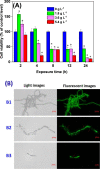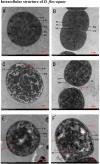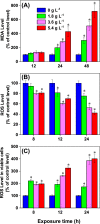The effects of aqueous extract from watermelon (Citrullus lanatus) peel on the growth and physiological characteristics of Dolichospermum flos-aquae
- PMID: 35577831
- PMCID: PMC9110734
- DOI: 10.1038/s41598-022-12124-5
The effects of aqueous extract from watermelon (Citrullus lanatus) peel on the growth and physiological characteristics of Dolichospermum flos-aquae
Abstract
Nowadays, the increasing Dolichospermum (Anabaena) blooms pose a major threat to the aquatic environment and public health worldwide. The use of naturally derived chemicals from plants to control cyanobacteria blooms has recently received a tremendous amount of attention. This study investigates the possibility of transforming watermelon peel (WMP) into a biological resource to allelopathically inhibit Dolichospermum flos-aquae blooms. The results demonstrated that the growth of D. flos-aquae was efficiently restricted by the aqueous extract of watermelon peel (WMPAE) in a concentration-dependent manner. Cell viability decreased quickly, intracellular structural damage occurred, chlorophyll a in algal cells degraded, and photosynthesis was clearly inhibited. At the same time, the levels of reactive oxygen species in viable cells increased significantly, as did malondialdehyde levels, indicating that WMPAE elucidated strong oxidative stress and corresponding damage to D. flos-aquae. Capsular polysaccharide (CPS) levels increased in all treatment groups, which represents an adaptive response indicative of the development of resistance to WMPAE stress and oxidative damage. Despite this, WMPAE had clear inhibitory effects on D. flos-aquae. These findings provide fundamental information on an allelopathic system that could be a novel and attractive approach for suppressing D. flos-aquae blooms in small aquatic environments, especially aquaculture ponds.
© 2022. The Author(s).
Conflict of interest statement
The authors declare no competing interests.
Figures








Similar articles
-
Physiological and morphological response of Aphanizomenon flos-aquae to watermelon (Citrullus lanatus) peel aqueous extract.Aquat Toxicol. 2020 Aug;225:105548. doi: 10.1016/j.aquatox.2020.105548. Epub 2020 Jun 18. Aquat Toxicol. 2020. PMID: 32593115
-
Phosphorus strategy in bloom-forming cyanobacteria (Dolichospermum and Microcystis) and its role in their succession.Harmful Algae. 2019 Apr;84:46-55. doi: 10.1016/j.hal.2019.02.007. Epub 2019 Mar 16. Harmful Algae. 2019. PMID: 31128812
-
Allelopathic Effects of Myriophyllum aquaticum on Two Cyanobacteria of Anabaena flos-aquae and Microcystis aeruginosa.Bull Environ Contam Toxicol. 2017 Apr;98(4):556-561. doi: 10.1007/s00128-017-2034-5. Epub 2017 Feb 9. Bull Environ Contam Toxicol. 2017. PMID: 28184984
-
Response of the cyanobacterium Microcystis flos-aquae to levofloxacin.Environ Sci Pollut Res Int. 2014 Mar;21(5):3858-65. doi: 10.1007/s11356-013-2340-3. Epub 2013 Nov 28. Environ Sci Pollut Res Int. 2014. PMID: 24288061
-
A review of the phylogeny, ecology and toxin production of bloom-forming Aphanizomenon spp. and related species within the Nostocales (cyanobacteria).Harmful Algae. 2016 Apr;54:21-43. doi: 10.1016/j.hal.2015.09.007. Harmful Algae. 2016. PMID: 28073477 Review.
Cited by
-
Citrullus mucosospermus Extract Reduces Weight Gain in Mice Fed a High-Fat Diet.Nutrients. 2024 Jul 8;16(13):2171. doi: 10.3390/nu16132171. Nutrients. 2024. PMID: 38999918 Free PMC article.
-
Allelopathy and underlying mechanism of mango (Mangifera indica) peel extracts on Alexandrium catenella.Front Plant Sci. 2024 Nov 26;15:1510692. doi: 10.3389/fpls.2024.1510692. eCollection 2024. Front Plant Sci. 2024. PMID: 39659420 Free PMC article.
References
Publication types
MeSH terms
Substances
LinkOut - more resources
Full Text Sources

